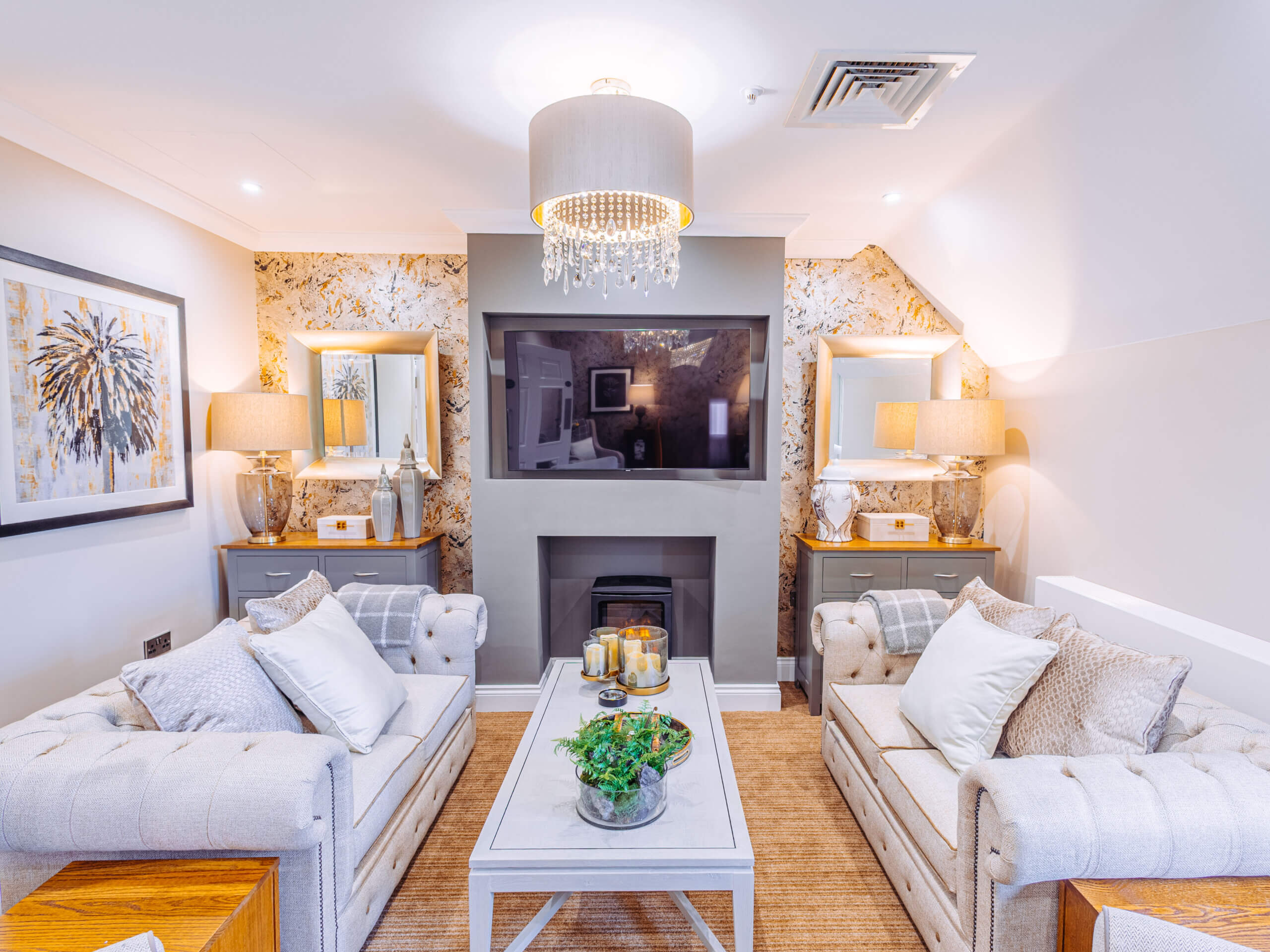As the UK’s population ages and expectations around later life care rise, luxury care homes are becoming an increasingly popular choice for those who want not only high-quality care but also comfort, style, and lifestyle amenities that are on a par with top hotels.
But what exactly defines a luxury care home and how much can families expect to pay?

Page contents
- Key points
- What defines a luxury care home?
- What facilities tend to be available in a luxury care home?
- Tips on how to choose a luxury care home
- How much do luxury care homes cost?
- What influences the cost of a luxury care home?
- Does a luxury care home have higher standards of care?
- Why choose a luxury care home?
- Are luxury care homes a growing trend?
Page contents
- Key points
- What defines a luxury care home?
- What facilities tend to be available in a luxury care home?
- Tips on how to choose a luxury care home
- How much do luxury care homes cost?
- What influences the cost of a luxury care home?
- Does a luxury care home have higher standards of care?
- Why choose a luxury care home?
- Are luxury care homes a growing trend?
Image: Lotus Manor care home. Credit Barchester
Key points
Premium living and personalised care – Luxury care homes offer high-end accommodation, hotel-style facilities, and tailored, person-centred care.
Exceptional amenities – They feature spa facilities, fine dining, beautiful gardens, and a wide range of wellbeing and lifestyle activities.
Higher costs – Luxury care homes typically cost £2,000–£4,500 per week, far above the UK average of £1,298.
Growing demand – More older adults are choosing luxury care due to rising wealth from an increase in house prices and higher expectations for comfort and lifestyle.
What defines a luxury care home?
A luxury care home goes beyond meeting basic care standards.
It offers:
- A strong focus on dignity, independence, and wellbeing
- Premium accommodation
- Bespoke care services
- Hotel-style facilities and hospitality
Many luxury care homes are run by specialist providers such as Barchester, Cinnamon Care, Signature Senior Lifestyle and Audley Villages, which aim to offer a five-star living environment combined with clinical excellence.
Holly Rance, head of Interior Design at Barchester Healthcare, describes a luxury care home as a place “where residents have the space to live well and team members have the facilities they need to deliver a high standard of care.” She explains that every detail from the artwork to the cutlery is chosen with residents in mind.
However she emphasizes it is not just about creating a beautiful environment, although we do that too – it is very much about our residents’ quality of life and offering person-centred care to each and every one of them.”
Cinnamon Care shares the same ethos. Director Carole Hunt says luxury begins “the moment you walk through our doors, with a warm, personalised welcome.”
Their homes feature stylish décor, premium finishes, gourmet dining, engaging activities, innovative technology, and a commitment to sustainability.
She says: “Across all our care homes, our teams are guided by Cinnamon’s strong values which include always treating residents with dignity and respect and accommodating their individual needs and preferences whenever possible.”
What facilities tend to be available in a luxury care home?
- Elegantly furnished bedrooms or suites – Spacious, en-suite rooms often furnished to a boutique-hotel standard, with residents having the option to personalise the décor.
- Fine dining – Restaurant-style dining rooms with menus designed by professional chefs, often using locally sourced ingredients and offering daily specials.
- Wellness and spa facilities – On-site spas, hair salons, and therapy rooms offering massages, beauty treatments, and holistic therapies.
- Leisure and lifestyle activities – Daily programmes that may include art workshops, music therapy, cinema screenings, wine tastings, and fitness classes.
- Beautiful surroundings – Landscaped gardens, lounges, and terraces designed for comfort and relaxation.
- Concierge and personal services – From laundry and housekeeping to arranging outings and appointments, everything is designed for convenience.
“At Barchester, our homes generally have a choice of lounges and different spaces for residents to enjoy so they can choose whether they want to take part in an activity, watch a film or perhaps have some quieter time reading or chatting,” says Holly Rance, head of Interior Design.
“Many of our homes have spa bathrooms, hair and nail salons for a bit of pampering, private dining rooms for families to use for special occasions, green spaces and covered outdoor areas.
We also like to include spaces for our residents to continue their hobbies or try new ones in our cinema rooms, activities rooms, and our gardens with their raised planters and potting sheds.”
Tips on how to choose a luxury care home
Carole Hunt, director of Cinnamon Care recommends that if you are searching for a luxury care home, you should “be guided by your first impressions – is the care home well maintained, were you offered refreshments, do the residents look happy, were team members interacting with residents, were there any malodours?
“Facilities such as fully furnished ensuite bedrooms should be a given but other amenities such as private dining areas for celebrating family occasions, a cinema room, hairdressers and nail bar also are indicators that the care home goes above and beyond.
Find out:
- What activities are on offer
- Is food prepared on the premises
- Is there a garden for residents to enjoy
- Can friends and relatives visit at any time?
The quality of the care is key.
- Take time to find out about the team member to resident ratio
- Ask about staff turnover
- Find out what training is undertaken by staff members
- Ask how many are agency staff.
- What technology is in place and how does it enhance care provision?
Ask questions about how birthdays are celebrated, whether the chef discusses meal choices with residents, and if outings and activities are organised outside the care home.
These will help to gain further insight about the care home’s ethos in your quest to discover the difference between good care and the outstanding care that a luxury care home should offer,” advises Ms Hunt.
You can look for a luxury care home on carehome.co.uk as here you will be able to read verified reviews about each care home and look at photos of the home and read all about its facilities.
How much do luxury care homes cost?
Luxury just by virtue of its name is going to cost more. Expensive décor, fine dining and elegant furnishing come with a hefty price tag.
The average cost of residential care in the UK is currently £1,298 a week.
Luxury care homes can cost significantly more, depending on location, room type, and care level.
Some of the top of the range care homes such as those run by Loveday have facilities such as a hydro spa, wellness studio, cocktail lounge and massage treatment room.
Their residential care costs range from £2,500 to £4,500 a week.
What influences the cost of a luxury care home?
- Location – Homes in London, Surrey, and the South East tend to charge higher fees due to property values and staffing costs.
- Room type – Premium suites or garden-view rooms with additional space or private balconies can raise weekly rates by several hundred pounds.
- Level of care needed – Complex nursing or dementia care typically adds £300–£800 per week.
- Extra services – Personal therapies, premium dining options, or private GP visits may incur extra charges.
Does a luxury care home have higher standards of care?
All registered care homes in the UK, luxury or otherwise, must meet the same minimum regulatory standardsset by the Care Quality Commission (CQC) in England (or equivalent regulators in Scotland, Wales, and Northern Ireland).
These standards cover:
- Safety and effectiveness of care
- Staffing qualifications and training
- Medication management
- Resident dignity and wellbeing
So every care home will have to meet these requirements whether it is a luxury care home or not and a care home can still be rated Outstanding and not be a luxury care home.
However luxury care homes can have higher staff to resident ratios giving residents a more personalised experience.
They also tend to offer a better standard of living.
Holly Rance from Barchester says: “A luxury care home adds to the residents’ overall experience and well-being, living in a well-designed space will help our residents relax and enjoy their time to the fullest.
“Working in a well thought through and well laid out home will help team members deliver better care. This is because they will be working more comfortably and accessing better facilities. A luxury care home certainly delivers better standards in terms of life enrichment and overall resident experience.”
Why choose a luxury care home?
For many families, the decision is also about wanting their relative to have a good quality of life, not just quality of care.
Luxury care homes allow residents to enjoy:
- A sense of independence and dignity in beautiful surroundings.
- Personalised care plans tailored to individual health needs and preferences.
- Social connection through a community of like-minded residents and varied activities.
- Peace of mind for relatives, knowing their loved one is safe, comfortable, and fulfilled.

While the cost can be substantial, some residents use proceeds from property sales, pensions, or savings to fund a lifestyle that aligns with their expectations for later life.
Are luxury care homes a growing trend?
In recent years, the UK has seen significant investment in purpose-built care homes designed to offer residents a more luxurious standard of living. These developments increasingly target self-funding older people who expect higher levels of comfort, lifestyle and service from residential care.
Rising property values have given many older adults greater financial resources to fund their care, and with this has come a shift in expectations.
More people now look for hotel-style amenities, smart interiors and a focus on wellbeing in later life.
They even rival five-star hotels
As a result, high-end care homes, some rivaling five-star hotels are becoming more common. One of the most notable examples is the Loveday group, founded by hotelier Laurence Geller in 2016. Located in some of London’s most prestigious postcodes, Loveday functions as an exclusive members’ club, with its Belgravia residence charging from £4,500 per week. Its facilities include a cocktail lounge, an art studio and a state-of-the-art gym.
Another example is Signature Highgate, a £50 million care home on Bishops Avenue, also known as “Billionaires’ Row.” The area has famously housed the Sultan of Brunei and Justin Bieber, and the home’s facilities are designed to match the prestige of its location.
Although these top-end luxury homes remain accessible only to a small minority, many care homes now describe themselves as luxury, often highlighting amenities such as spas, cinemas and health clubs.
This surge in high-end care reflects the growing wealth of the UK’s older population, due to rising house prices.
People aged 65 and over now hold 51% of the nation’s wealth. This is up from 42% in 2008, according to the Resolution Foundation.
With greater financial means and rising expectations, many older people are increasingly seeking comfort, lifestyle and choice in later life.


